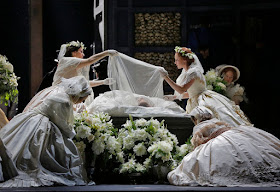 |
| Ensemble in tomb scene of Roméo et Juliette at Santa Fe Opera |
Santa Fe Opera
The Crosby Theatre, Santa Fe
RODNEY PUNT
Gounod's Roméo et Juliette finally received its company debut at the Santa Fe Opera, a mere century and a half after it first broke hearts in Second Empire Paris.
No other Shakespeare play has inspired so much music. While Gounod's score erases no memories of treatments by Berlioz (symphony), Tchaikovsky (tone poem), Prokofiev (ballet) and Bernstein (musical), all of which are among their composers' greatest works, credit Gounod for the tale's most successful operatic incarnation.
With its libretto graced by the deft stage reduction of Jules Barbier and Michel Carré, the action focuses on the young lovers, giving them sumptuous solos and duets. If the work has a weakness, it may lie in its predominant sweetness. Shakespeare's depiction of destructive male competition is one of the elements that makes the tragedy of trampled tenderness so wrenching. Smoothing the play's rougher edges, as here, can lean the drama toward flaccidness.
With its libretto graced by the deft stage reduction of Jules Barbier and Michel Carré, the action focuses on the young lovers, giving them sumptuous solos and duets. If the work has a weakness, it may lie in its predominant sweetness. Shakespeare's depiction of destructive male competition is one of the elements that makes the tragedy of trampled tenderness so wrenching. Smoothing the play's rougher edges, as here, can lean the drama toward flaccidness.
 |
| Solomon Howard (the Duke) and Ensemble |
 |
| Raymond Aceto (Frère Laurent) and Ailyn Pérez (Juliette) |
At the performance this reviewer took in, understudy tenor Joshua Guerrero, in an ill-fitting costume, substituted at the last moment for an ailing Stephen Costello. Credit is due him from a grateful management, but winning audience hearts would have to be postponed to another day. Guerrero held his own vocally, though his wooden acting provided no dramatic counterpart to Pérez's radiant Juliette. Amatory chemistry, where wert thou? As the designated understudy, Guerrero's task was not just an obligation, but an opportunity.
Director Stephen Lawless handled the scenes of the two lovers sensitively and moved the large ensemble cast well. He also inserted a couple of less successful identity-twisting gimmicks in secondary characters. Raymond Aceto’s otherwise splendid Frère Laurent was reimagined as an apothecary, adding virtuosity to his potion-making abilities but sacrificing some of his spiritual warmth. Likewise, the page Stéphano (a marvelous Emily Fons, who owns the trouser roles at Santa Fe) was assigned extra fussiness to her aria, as s(he) becomes also lead dancer in a campy trio of swishy young soldiers. The routine's insertion here seemed incongruous, as if it belonged to another opera.
 |
| Beth Miller (dancer) and Emily Fons (Stéphano) |
 |
| Ailyn Pérez (Juliette) |
Susanne Sheston's choral forces gave powerful voice to the family feud and its reconciliation. The performance greatly benefitted from the sensitive orchestral persuasions of the Opera's Chief Conductor, Harry Bicket, whose extra duty that evening kept his Roméo right on cue, at least musically.
---ooo---
Performance reviewed: July 29, 2016. Photos by Ken Howard

No comments:
Post a Comment
Note: Only a member of this blog may post a comment.